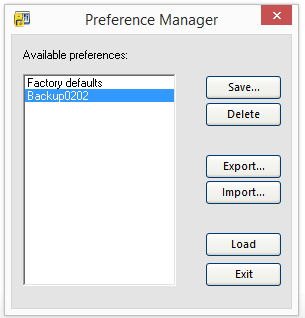
Preferences Manager allows you to edit these preferences in a simple and easy way. But in the case of a rooted device, theses files can be read, edited and even deleted. It consists in a simple XML file stored in the private folder, specific to the app. Unfortunately, this method is not very secure. It's a simple way to store private primitive data in key-value pairs. The most frequent solution is the Shared Preferences framework. This application requires a rooted phone! Without root access, it can't do anything.Īndroid provides several options for developers to save application data. The policy is also shown in the profiles list.Īssign the profile and monitor its status.įor more information on preference files for Microsoft Edge, see Configure Microsoft Edge policy settings on macOS.Preferences Manager is an Open Source application that allows you to seamlessly edit application's preferences. When you select Create, your changes are saved, and the profile is assigned. In Review + create, review your settings. For more information on assigning profiles, see Assign user and device profiles. In Assignments, select the users or groups that will receive your profile. For more information about scope tags, see Use RBAC and scope tags for distributed IT. In Scope tags (optional), assign a tag to filter the profile to specific IT groups, such as US-NC IT Team or JohnGlenn_ITDepartment. To see some property list file examples, go to Set preferences for Microsoft Defender for Endpoint. For example, your property list file should be similar to the following file: SomeKey The file should only have key value pairs, and shouldn't be wrapped in, , or tags. If you need to change the key information, open the list file in another editor, and then reupload the file in Intune.īe sure your file is formatted correctly. The key information in the property list file is shown. For example, upload a ist or YourApp-Manifest.xml file. Property list file: Select the property list file associated with your app. For more information, see Settings catalog. When you create a preference domain, a bundle ID is also created.įor Microsoft Edge version 77 and newer, you can use the settings catalog. Property list files are typically used for web browsers (Microsoft Edge), Microsoft Defender for Endpoint, and custom apps. Preference domain name: Enter the bundle ID, such as. In Configuration settings, configure your settings: This setting is optional, but recommended. Description: Enter a description for the policy.For example, a good policy name is macOS: Add preference file that configures Microsoft Defender for Endpoint on devices. Name your policies so you can easily identify them later. Name: Enter a descriptive name for the policy.In Basics, enter the following properties: Profile: Select Templates > Preference file.Select Devices > Configuration profiles > Create profile. Sign in to the Microsoft Intune admin center. Tasks you can complete using the Settings Catalog in Intune is also a good resource. To see the settings you can configure, create a device configuration profile, and select Settings Catalog. Not all settings are documented, and won’t be documented. Intune may support more settings than the settings listed in this article. If some settings aren't available in the settings catalog, then it's recommended to continue using the preference file. For a list of the settings you can configure, see Microsoft Edge - Policies (opens another Microsoft website).īe sure macOS is listed as a supported platform. If you're configuring the Microsoft Edge version 77 and newer app, then use the Settings catalog.

Property list files target the entire device. Only some apps work with managed preferences, and might not allow you to manage all settings.īe sure you upload property list files that target device channel settings, not user channel settings. Apple recommends removing non-manageable settings using Xcode before importing the file.

Then, review the app's preference file using Xcode to see how the setting is configured.
#Google preference manager how to#
If you're not sure how to enter an app key, change the setting within the app. Be sure to test your changes before assigning the profile to your devices.

These settings are added to a device configuration profile in Intune, and then assigned or deployed to your macOS devices. As part of your mobile device management (MDM) solution, use these settings to add the app bundle ID ( ), and add the app's. This article describes the different property list file settings you can add to macOS devices. For more information, see About Information Property List Files (Apple's website) and Custom payload settings. Property list files include information about macOS applications. Using Microsoft Intune, you can add a property list file (.plist) for macOS devices, or apps on macOS devices.


 0 kommentar(er)
0 kommentar(er)
